[This is another paper I wrote in graduate school for my 20th Century Fine Printing history course. The original was written in 1993.]
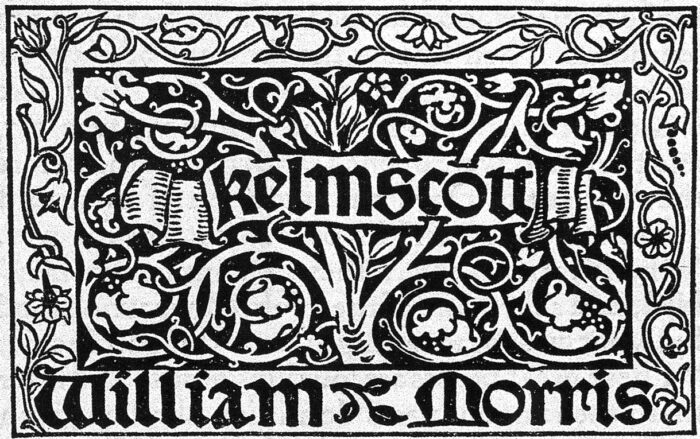
Colophon for the Kemscott Press (Wikipedia)
The Kelmscott Press peaked over a hundred years ago, yet its influence has lasted through the years and spread across the world. The ideals that Morris strove to achieve inspired a whole generation of private presses. Founded in honor of these ideals, these printers were in England, Germany, Scandinavia and the United States. The long range effect of William Morris was a significant upgrading of book design and typography throughout the world.[1]
In England, three presses inspired by Morris’s ideals stand above the rest. These were the Doves Press, the Ashendene Press and the Vale Press. Of the three, the Doves Press was the most distinguished successor of the Morris legacy.[2] The Doves Press was founded in 1900 by T.J. Cobden-Sanderson and Emery Walker. Walker had been a friend of Morris’s, and it was his study of typography that inspired Morris to design his own typefaces. The Doves Press emulated the Kelmscott Press in the details of paper, vellum and bindings. The type designed and used for the books of the press were based on the Jenson type, as was Morris’s Golden type. Unlike Morris’s books however, the Doves Press used ornament sparingly and usually only in the form of woodcut letters. These were designed by the master calligrapher Edward Johnston. Johnston’s career as an artist had also been inspired by the work of William Morris.
The partnership between Cobden-Sanderson and Walker ended in 1909 and the press closed in 1916. The significance of the Doves Press was in its ability to set Morris’s principles into motion while maintaining an undecorated and simplified page design. The Doves Press could not have existed without the theories and practice of Morris lying behind it.[3]
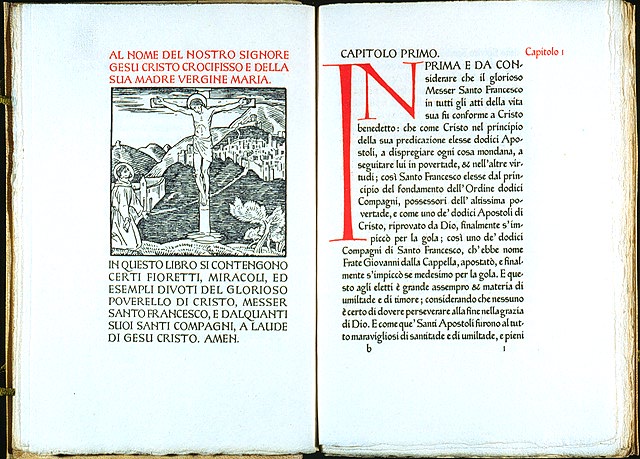
St. Francisc of Assisi, printed by the Ashendene Press, 1922 (Wikipedia)
The Ashendene Press was already in production before the end of the Kelmscott Press. Its early books were generally unimpressive. The look and philosophy of the press changed in 1895 when founder C. H. St. John Hornby visited the Kelmscott Press. In addition to inspiration from Morris, Hornby was also influenced by Emery Walker and in 1900 was persuaded to create his own type. The type designs for the Ashendene were inspired by semi-gothic types used by Sweynheym and Pannartz in Subiaco.[4] The Subiaco type was used by the press until 1935. The work done at the Ashendene press demonstrates that it was possible to be a disciple of Morris without direct imitation of the Kelmscott books. [5]
The Vale Press, established by Charles Ricketts in 1896, was inspired by the Kelmscott Press but openly attempted not to copy Morris’s book style directly. Ricketts commented in his essay “A Defense of the Revival of Printing” (1899) that it was too easy for the Kelmscott style to be debased by less talented designers.[6] The Vale Press used a slab-serifed Roman face designed by Ricketts, also inspired by the Golden type. Its page designs were ornamental in the Morris trend but tended to be lighter and less cluttered.
The artist Aubrey Beardsley was influenced by Morris in a round about way. Beardsley had attempted to design pages for the Kelmscott Press and Morris rejected his designs. In an attempt to spite Morris, Beardsley’s page designs for the Dent edition of Le Morte D’Arthur, parody the Kelmscott page style. His success with this project secured his place as a successful illustrator.
The spread of Morris’s ideals outside England was felt strongest in Northern Europe and in the United States. In Germany, Morris’s predilection towards medieval practices was the impetus towards the German renaissance of the Arts and Crafts movement. Of the practitioners in this era, Rudolf Koch stands above the rest. Koch shared Morris’s medieval beliefs and this showed in his work. He taught at The Arts and Crafts School in Offenbach am Main. Koch took Morris’s beliefs a step further in that he was inspired to create handmade manuscript books. He also was an accomplished type designer, designing several interpretations of medieval fonts as well as the still popular display face Neuland.
In a less tangible way, Morris’s ideas inspired the beliefs of many European avant-garde and German Werkbund artists. These artists were drawn to Morris’s belief in the hand- crafted aesthetic, yet they were inspired to embrace the machine age and join the two concepts to create a machine/crafted aesthetic. This was one of the founding principles of the great Bauhaus school.
When Morris’s ideas reached America they started a craze among commercial printers. His ideas spread across the country to such an extent and degradation that many American printers and designers were alarmed. Bruce Rogers recalled in 1912 that, “For a period of ten years the work of William Morris had an enormous influence on American printing – and not, on the whole, a beneficial one, except in its insistence upon sound craftsmanship.” [7]
The most notable printers in the United States to show understanding and synthesis of Morris’s principles were Frederic Goudy, Daniel Berkeley Updike, Bruce Rogers and Elbert Hubbard.
Frederic Goudy had been working as a bookkeeper, when he first encountered the works of the Kelmscott Press, including the famous Chaucer, as well as books from other English private presses.
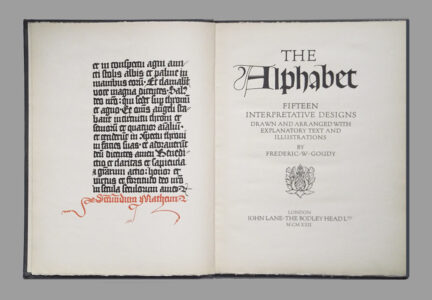
The Alphabet by Frederic Goudy, image from Flickr, eye magazine, https://www.flickr.com/photos/eyemagazine/5973887036
Goudy eventually opened a small press, acquired Morris’s Chaucer press, and began designing typefaces. By 1899, he was a successful freelance designer and typographer in Chicago. He later opened the Village Press and designed the type for the press based on the Golden type. In 1908 the press was destroyed by fire. It was after the press closed that he focussed his attention on to type design. By his own count, Goudy designed a total of 122 faces. He based many of his faces on the work of other designers as well as many medieval and renaissance models. Goudy helped to spread the Morris principles to other printers through several books he wrote on the art of typographic design. These included The Alphabet (1908), Elements of Lettering (1921) and Typologia (1940).
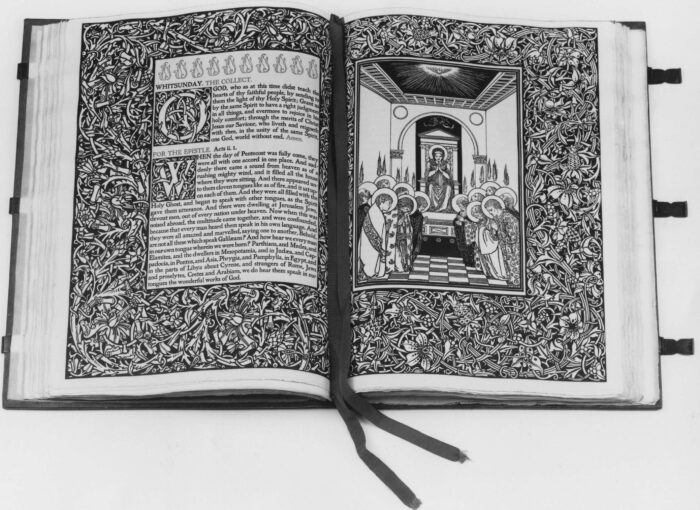
Pages from the Alter Book, published by Merrymount Press. Image from the special collections at the Providence Public Library.
The work of Daniel Berkeley Updike, in relation to the Kelmscott Press, is summed up in the work of one book. The Alter Book, designed in the early 1890’s, was conceived from the start as a homage to The Kelmscott Press. This book has been called “the most stupendous tribute to the influence of the Kelmscott Press ever published in the US (or any other country).”[8] Updike’s later work shows a maturation of the Morris influence.
The book designer Albert Bruce Rogers began his career of total book design as direct result of seeing the Kelmscott books. His early book designs show imitation of Morris’s style. [9] Unlike Morris, Rogers was not against the use of mechanical typesetting equipment and modern printing presses. He did however, assimilate the ideals advocated by Morris and synthesize them into brilliant and versatile limited edition books. Beatrice Ward, writing on Rogers said that Rogers “managed to steal the Divine Fire which glowed in the Kelmscott Press books and somehow be the first to bring it down to earth.” [10]
Perhaps the best known press in the US that outwardly professed a discipleship to Morris was Elbert Hubbard’s Roycroft Press. The early Roycroft Press worked with hand presses, but Hubbard soon moved to power machines. Although inspired by Morris, Hubbard’s philosophy about machines and consumerism differed greatly from the Morrisonian ideal.
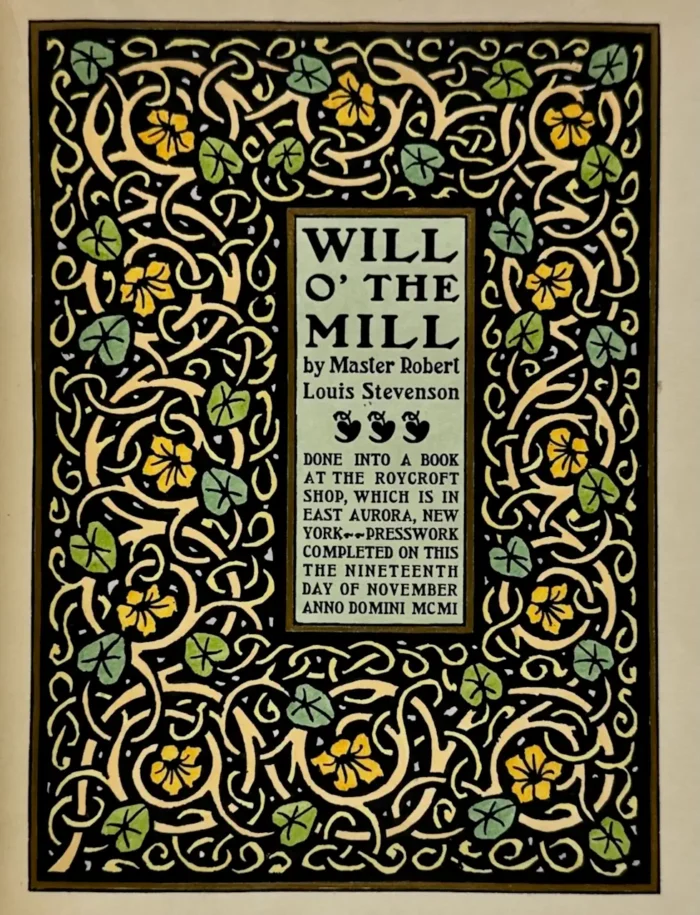
Will O’ The Mill title page, Roycroft Press, 1901.
Hubbard considered himself Morris’s chief disciple in the United States and the style of his early books were clearly adapted from the Kelmscott style. As the Roycroft press progressed in production, its style evolved to take on a more Arts and Crafts and even Secessionist style. This was due to Hubbard’s genius in hiring young talented designers. Among these were Will Ransom and Dard Hunter. The latter of which was to move the look of the books increasingly towards the Secessionist style. Hubbard was incredibly successful in elevating the design and quality of commercial book production. His contribution to printing is recognized in the fact that he brought the beautiful book to groups of people usually not interested or associated with this type of craftsmanship. Hubbard’s marketing skill was in targeting and pricing his books to appeal to the wider audience.
The legacy of Morris’s concept of the ideal book has served to redefine the attitude of printers and consumers towards what the book should be. The attitudes towards fine craftsmanship, materials and the social value of the ideal book first voiced by Morris, have continued to prosper in the work of today’s private presses and book designers.
[1]Philip Meggs, The History of Graphic Design , 2 ed. ( New York: Van Nostrand Reinhold, 1992), 185.
[2]William S. Peterson, The Kelmscott Press – A History of William Morris’s Typographical Adventure (United States: University of California Press, 1991), 279.
[3]Ibid, 281.
[4]Meggs, 184.
[5]Peterson, 282.
[6]Ibid.
[7]Ibid, 298.
[8]Ibid, 305.
[9]Ibid, 308.
[10]Meggs, 189.
Bibliography
Meggs, Philip, The History of Graphic Design. 2 ed. New York: Van Nostrand Reinhold, 1992.
Peterson, William S., The Kelmscott Press – A History of William Morris’s Typographical Adventure. United States, University of California Press, 1991.